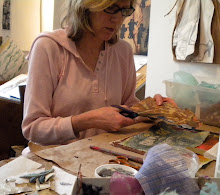I attended the 2012 Armory Show at piers 92 and 94 on Friday night. I was not interested in seeing contemporary art, although I know this is an opportunity to see art trends from outside NYC. I was particularly looking forward to seeing the work by Morandi that the NY Times had talked about and the other gems by established artists that galleries bring to these shows. I love the intimate exposure to the art, conversing with gallery representatives, and just wallowing in art for a few hours. On this occasion, with a few notable exceptions, I found myself drawn to prints and sculptures.
Entering the show at the Marlborough Gallery booth we were greeted by two clever sculptures referencing other objects. One, at first glance, is a bookcase filled with incredibly worn old books. But, no, stepping closer, it becomes apparent that this is a stack of roughly hewn blocks of wood, definitely wood yet with the slump, tilt, color and scale of old books.

The other sculpture (at left) was made of smooth marble, immediately recognizable as a reference to the central figure from
Velazquez' Las Meninas in its color, shape and texture.
Onward, in search of those Morandi paintings. . . They were at the Galleria d'Arte Maggiore booth.
Now, I missed the Giorgio Morandi retrospective at the Metropolitan Museum of Art in 2008, much to my regret. His paintings are not often on view and especially not in quantity. I have wanted to experience them in person ever since my first painting teacher at the University of Iowa would use Morandi's paintings as examples in his critiques. One of the challenges of being in art school in Iowa was that our access to actual paintings was limited, mostly through slides and books, so I'm not sure I ever understood what my professor was trying to tell me. (Imagine all my "aha" moments visiting European art museums after graduate school. But that's another blogpost. . .)
 |
| Morandi painting |
So, here I was, finally nose to nose with Morandi's oil paintings. The first thing that struck me, aside from the quiet tones and static composition, is the way the brushstrokes describe the forms. The artist's hand is present, building the surface of the painting. The warm versus cool tones of beige, push and pull the forms in the picture plane. The atmosphere around the objects has a palpable presence, almost as if the whole painting was formed in clay. This is not the world of atmosphere and shadows that we live in, but rather the painting obeys its own laws of physics.
 |
| Morandi etching |
Shown in conjunction with the paintings were some etchings, with the same kind of vessel forms as subject matter and of the same scale as the paintings. Of course, this being an etching, the marks build the surface of the print. This is a claustrophobic environment. But, there's something else going on here, too. Forms appear to have been cut and applied to the surface, rather than emerging from the muck of the background as in the paintings. Although dimensionality is represented with highlights and crosshatched shading, those marks also look like decoration on the surfaces of flat forms. Light is malleable and somewhat arbitrary.
There were also some delicate watercolors by Morandi, obviously done on site, which explored outlines of forms and stark contrasts of light and dark. This booth offered a richly satisfying taste of my painting professor's hero. Maybe I am finally learning the lessons he was trying to teach
me.
More favorites at the show:
 |
| Henry Moore, Studies 1942 |
 |
| Jacob Lawrence at DC Moore |
 |
Scrumptious prints by Marylyn Dintenfass at Babcock Galleries
|
I continue to be astonished that tempera can be such a beautiful medium in Jacob Lawrence's hands.
 |
| Helen Frankenthaler, Ukiyo-e style woodcuts at Pace Prints |
Would somebody please tell me how these woodcuts are made? This photo does not begin to show the layers and subtleties in these prints. They are so fresh, lively and painterly.
A quick walk through the Contemporary section of the show was interrupted by a visit to this sculpture. Drawn to it by the noise of many ball bearings moving across a slowly slanting steel plate, this sculpture is the kind of thing you could sit and watch for hours, like a fire. It reconfigures itself according to some laws of physics which elude me. It reminded me of those Morandi paintings again with their internal laws of physics. And the patterns that the ball bearings created were like those brushstrokes.
 |
| Wave of Matter, Tommi Grönlund - Petteri Nisunen, Galerie Anhava |

After nearly two and a half hours of intense looking and a head full of images that were the results of lifelong artistic explorations, not to mention walking on a concrete floor, I was worn out. I could relate to this sign (at left) near the exit.
All in all, a satisfying visit to this year's Armory Show. I felt as though I had feasted on some very rich food indeed.




 $50.00 | Buy now | Visit my Etsy shop
$50.00 | Buy now | Visit my Etsy shop

































